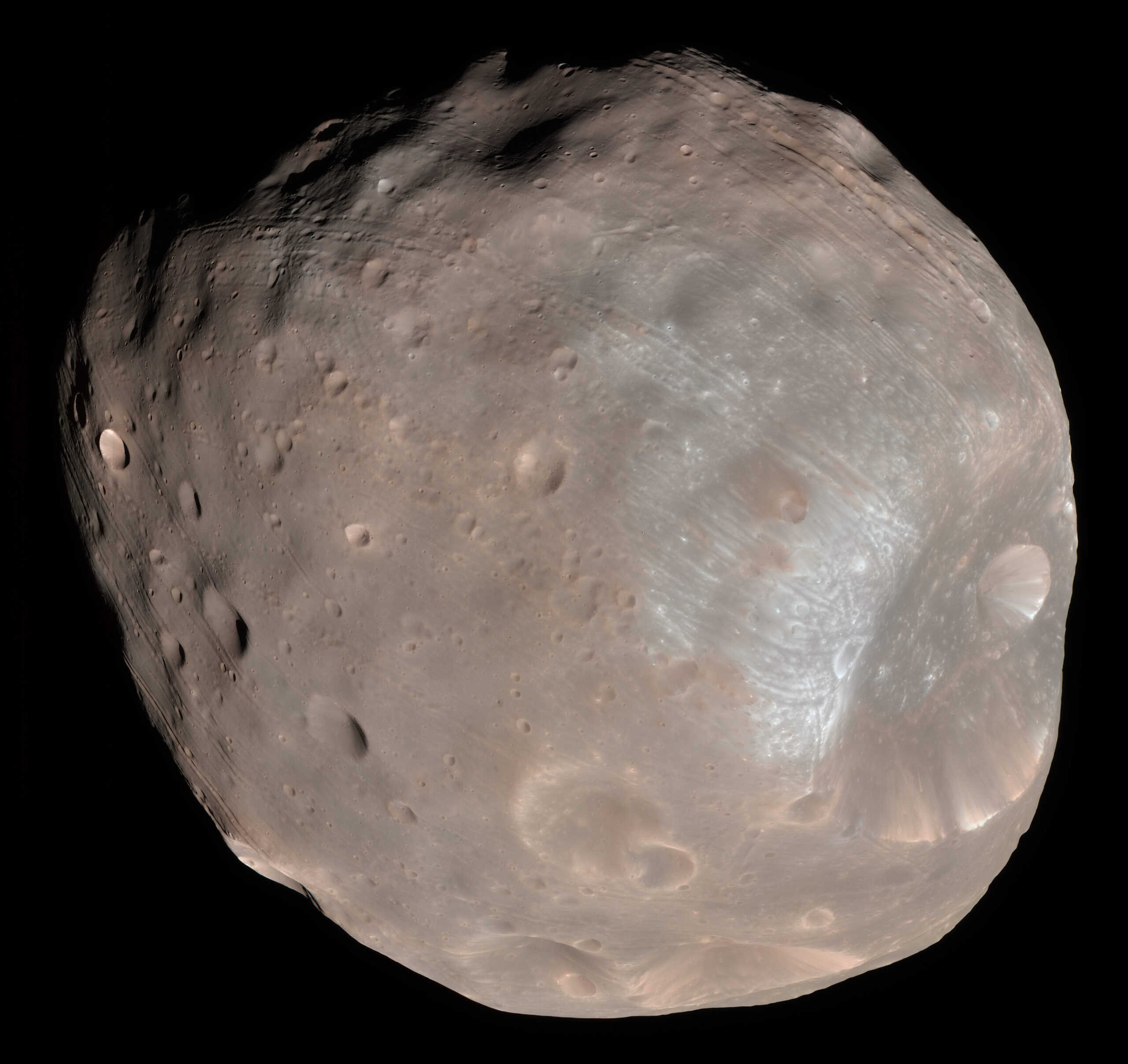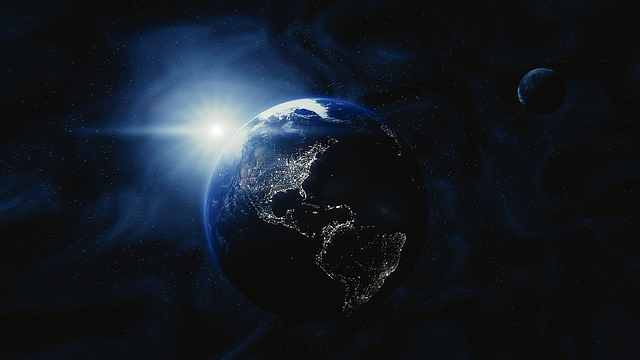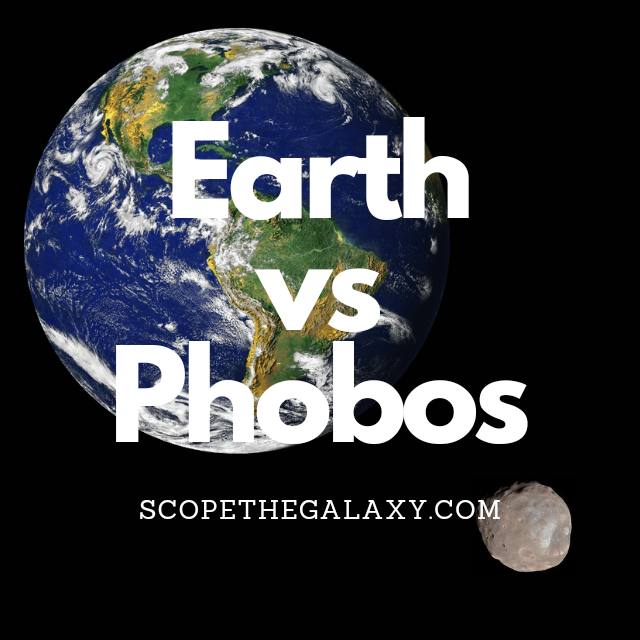*This post may contain affiliate links. This means we may make a commission if you purchase an item using one of our links*
The main differences between Earth and Phobos are that Earth is the largest terrestrial planet in our solar system with a diameter of 12,724km compared to the much smaller 22.53km, Earth is able to sustain intelligent life while Phobos cannot and Phobos is tidally locked to Mars while Earth is not tidally locked to anything.
There are various other differences between the two so, continue reading if you want a more detailed look at both Phobos and Earth along with their similar features and differences.
What Is The Moon Phobos?
Table of Contents

Phobos is the larger and innermost of the Martian moons, named after the Greek God of fear and panic. This rocky satellite measures approximately 27 x 22 x 18 kilometers and possesses an irregular shape.
Flying only 270 km above Mars’s surface, Phobos orbits the Martian surface so closely that it spins around the planet three times a day (each orbit takes 7 hours and 39 minutes). And this proximity means that the moon cannot always be seen from Mars’ surface (it all depends on where you’re standing).
In general, Phobos rises in the west, passes through the sky in around 4 hours, and sets in the east. And this process occurs twice during one Martian day.
Phobos travels 1.8 m closer to Mars every 100 years, which means this doomed moon will one day crash into its planet or break up into rings. Still, this won’t happen for another 50 million years or so.
The moon is covered in streak patterns from impact craters, the most significant of which is the crater Stickney, with a diameter of 9.7 km. Phobos has weathered thousands of meteorite impacts, one of which almost shattered it to pieces.
It was first discovered by the American astronomer Asaph Hall on 17th August 1877. But, it can be difficult for astronomers to see as it is one of the least reflective bodies in the solar system with an albedo of 0.071.
Despite its small stature, Phobos experiences wildly varying temperatures on its dark side compared to the light side. Measurements on the light side of the moon suggest that temperatures can rise to -4 degrees Celsius, a sort of brisk winter’s day that would be cold but tolerable.
In contrast, temperatures on the dark side can drop to -112 degrees Celsius, even though the two areas are just a few kilometers apart. The probable cause is fine surface dust that cannot retain heat, allowing temperatures to drop rapidly.
The low density of Phobos suggests its composition is similar to carbonaceous chondrite meteorites, which could mean that Phobos is a captured asteroid.
What Is The Planet Earth?

Our home planet Earth is the 3rd farthest planet from the Sun, made up of a mixture of water and solid rock like objects, and is the only entity in our solar system known to allow intelligent life forms like ourselves to exist.
Earth’s distance of 152 million km from the Sun has allowed it to remain within the goldilocks zone and as a result, the planet has been able to thrive for millions of years. It orbits the Sun in a circular pattern, much like all the other planets, has only one natural satellite which would be the Moon and is a terrestrial planet to boot.
In regards to its diameter, Earth is the 5th largest planet with a diameter 12,742km.
Earth’s temperature ranges based on the region you’re located where it can be from as low as -94 degrees Celsius in Antarctica to as high as 50 – 55 degrees Celsius in Tunisia.
As for the planets composition, it consists of the crust, the mantle, the outer core and the inner core, where the inner core is the hottest element within the Earth reaching temperature in excess of 5,200 degrees Celsius.
In regards to some of its most unique features, Earth is around 71% water, has an atmosphere consisting mostly of oxygen and nitrogen that is also made up of 5 main layers, with the highest to lowest being the troposphere, stratosphere, mesosphere, thermosphere and exosphere.
A day on Earth is 24 hours and an orbital cycle around the Sun takes 365 days to complete. It’s axial tilt is more distinct at 23.5 degrees to the right.
Similarities Between Phobos And Earth
Phobos and Earth do have their odd few similarities, which in this case includes the below:
- Both have a rocky surface.
- Both are a spherical shape.
- Both are part of the same solar system.
- Both have no rings surrounding them.
Differences Between Phobos And Earth
In regards to the differences between the two, they include the below:
- Phobos orbits Mars whilst Earth only orbits the Sun.
- Earth is a spherical shape while Phobos is not.
- Earth has 1 moon while Phobos has no other objects orbiting it.
- Earth is a terrestrial planet whilst Phobos is a terrestrial based natural satellite.
- Earth has a nearly circular orbit while Phobos has a far more drastic elliptical orbit
- Earth has a diameter of 12,742km whilst Phobos has a diameter of 22.53km.
- Phobos has no atmosphere whilst Earth has a far thicker atmosphere composed of 5 main layers.
- A day on Phobos takes 7 hours 39 minutes whilst a Earth day takes 24 hours.
- It takes Phobos 7 hours 39 minutes to orbit Mars and around the Sun in 687 days whilst Earth orbits the Sun in 365 days.
- Earth has an axial tilt of 23.5 degrees whilst Phobos’ axial tilt is closer to 0.
- Phobos’ temperature ranges between -4 to -112 degrees Celsius whilst Earth has an average temperature of 13.9 degrees Celsius.
- Earth is the only known planet that is able to sustain intelligent life.
- Earth’s density is 5.51 g/cm³ whilst Phobo’s density is 1.88 g/cm³.
- Earth’s mass is 5.972 × 10^24 kg whilst Phobos’ mass is 10.6 × 10^15 kg.
- Phobos’ gravitational strength is 0.0057 m/s² whilst Earth’s is 9.81 m/s² .
- Phobos is tidally locked to Mars whilst Earth is not tidally locked to anything.
- Phobos only orbits Mars 6,000km away and is getting closer to the planet by 1.8 meters every 100 years.
- Earth has volcanoes and is volcanically active while Phobos is not.
- Earth has a hotter central core while Phobos does not.
Summary
Earth and Phobos may both be part of the same solar system and are terrestrial based but, they certainly differ more than they have in common.
Whether it be in regards to size, mass, temperature, their atmospheric composition, orbital pattern, their ability to sustain life and more so, all things considered Earth is the most unique entity in our solar system due to its ability to sustain intelligent life.

